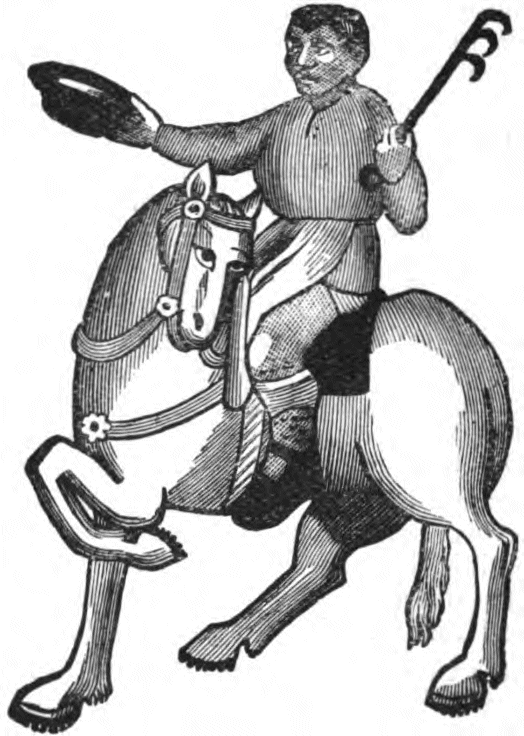

THE COOK
If not so great a knave as the Pardoner or Summoner, the Cook is among the most disreputable of Chaucer's pilgrims. Though he could make blanc-manges and mortreux, we are not to think of him as a chef, able to superintend one of the portentous medieval banquets, but as the proprietor of an eating-house, wont to stand outside his shop crying "Hote pies, hote, Good gees and grys (pigs), Go we dyne, go we!” like the cooks and their knaves in Langland's Vision (Prologue, 1. 104 sq.), or the sellers of 'Hot shepes feete' in Candlewick Street, of whom we read in the London Lykpenny. When, in his unseemly delight at the Miller's tale, he offers to tell a story himself, the Host says to him:
| "Now telle on, Roger, looke that it be good; For many a pastee hastow laten blood, And many a Jakke of Dovere1 hastow sold, That hath been twies hot and twies cold; Of many a pilgrim hastow Cristes curs, For of thy percely yet they fare the wors, That they hav eten with thy stubbel goos. For in thy shop is many a flye loos." |
1The commentators are uncertain as to whether a Jack of Dover was a sea-fish or a pudding.
The tale he begins to tell is of a rascally apprentice, and we lose little by its being left a mere fragment. As the pilgrims near Canterbury he becomes so drank that he falls from his horse,
| "And er that he agayn were in his sadel Ther was greet shovying, bothe to and fro, To lifte hym up, and muchel care and wo, So unweeldy was this sory, pallid goost." |
In the Ellesmere picture he is represented holding a three-pronged flesh-hook in one hand and his hat in the other, as if appealing to the company for a hearing.
379. A Cook they hadde with hem, etc. Apparently the gildsmen, anxious, like city magnates of the present day, that they should have plenty of good fare, had taken the Cook from his shop to cook for them in case of any deficiencies in the inns on the road.
for the nones. See note to 1. 545.
382. Londoun ale. Tyrwhitt informs us that a century later (in 1504) London ale was priced at 5s. a barrel more than that of Kent. Apparently in Chaucer s time it was already famous.
384. mortreux. "Mortrewes we find from a printed Ms. of the Royal Society of Ancient Cookery,' consisted of pork or other meat brayed in a mortar (in the French, une mortreuse, and hence the name), mixed with milk, eggs, spices, etc., and coloured veiy deep with saffron" (Saunders).
387. blankmanger. This appears to have been made of grated capon, milk, cream and rye-flour, boiled with sugar and rose-water.
--o--
These notes are reproduced verbatim from Alfred W. Pollard, Chaucer's Canterbury Tales: The Prologue, London: Macmillan, 1903. The book is in the public domain and available for viewing and download from Google Books. Although the book is old, the notes are generally enlightening and accurate. Nevertheless, users doing detailed research on aspects of the General Prologue should, if possible, also consult more recent notes in print publications such as The Riverside Chaucer, ed. Larry D. Benson, 3rd ed., Boston: Houghton Mifflin, 1987.